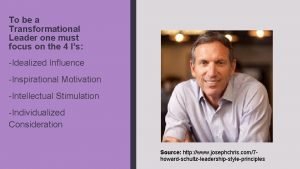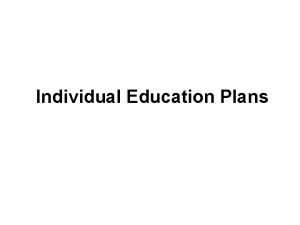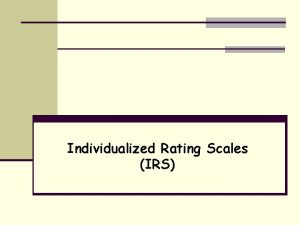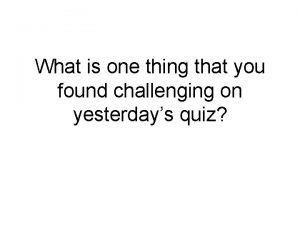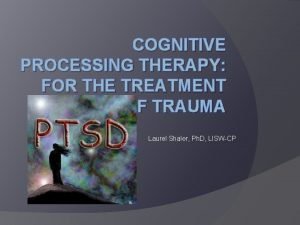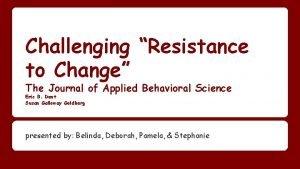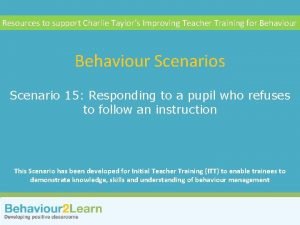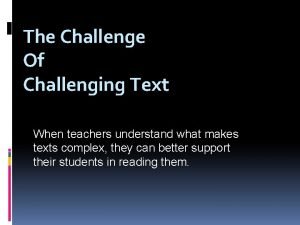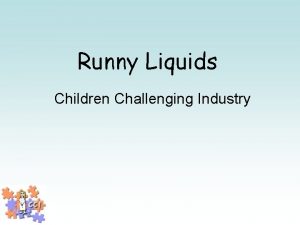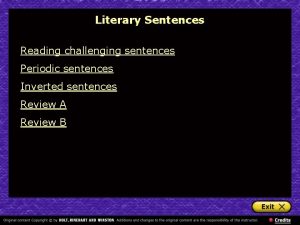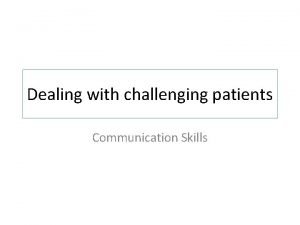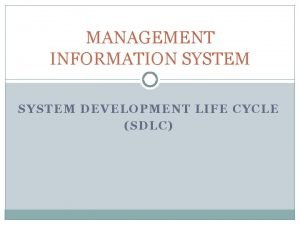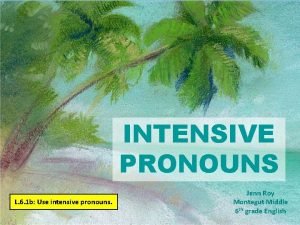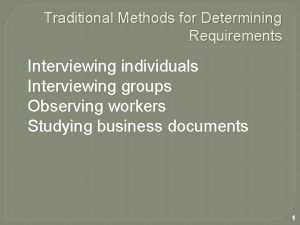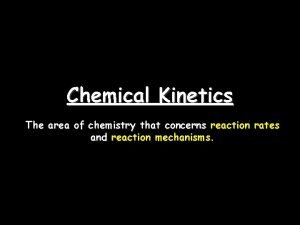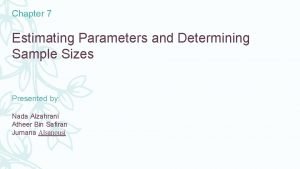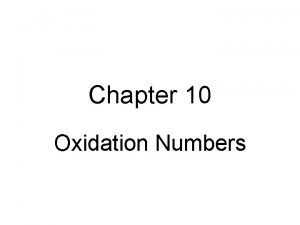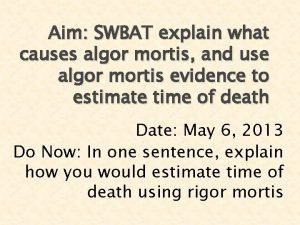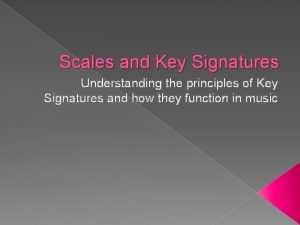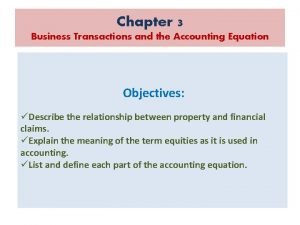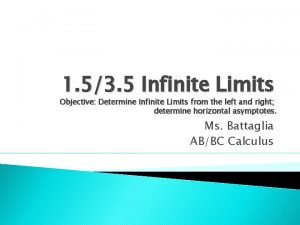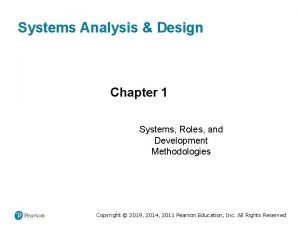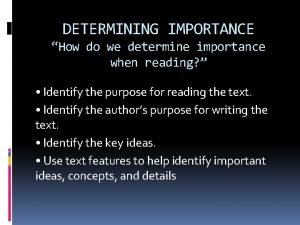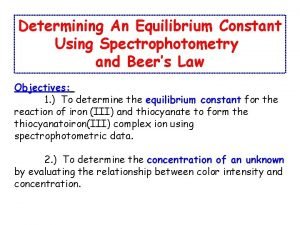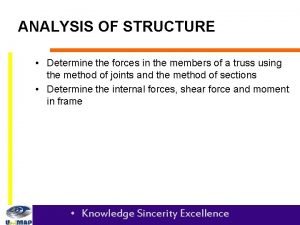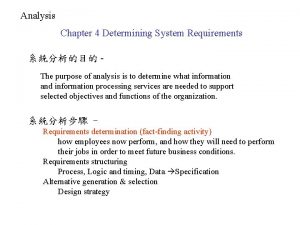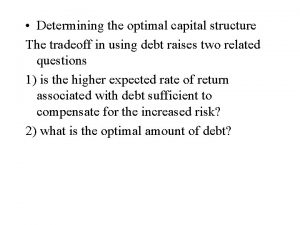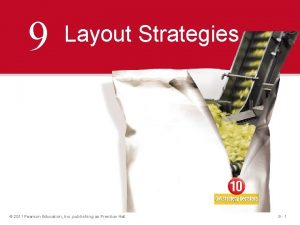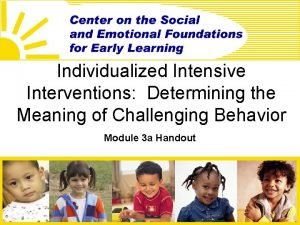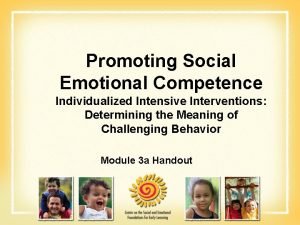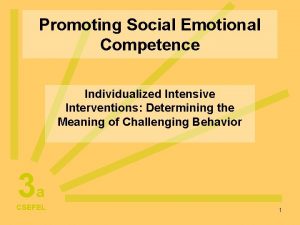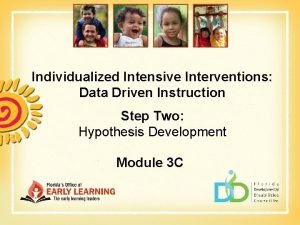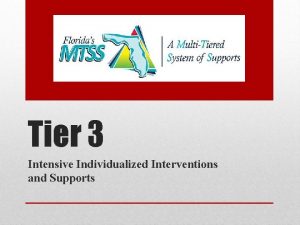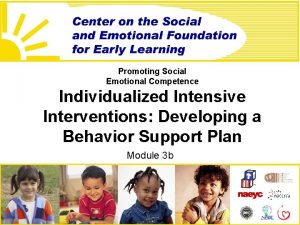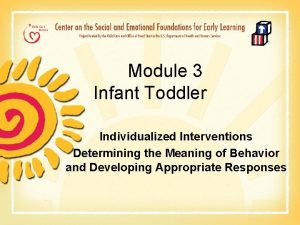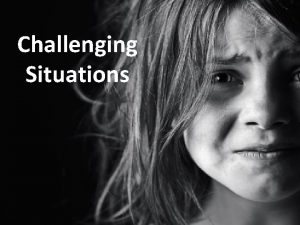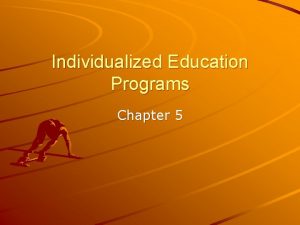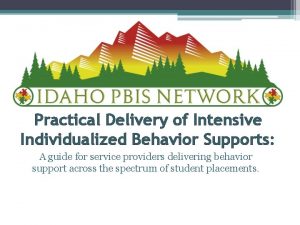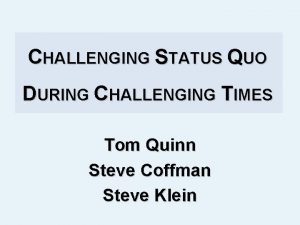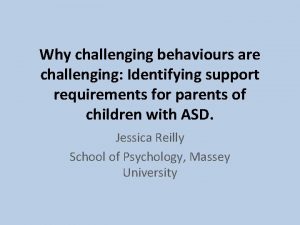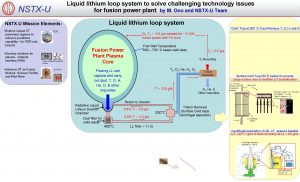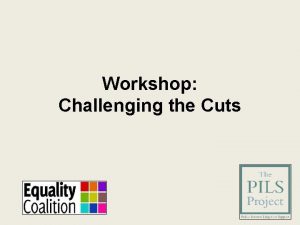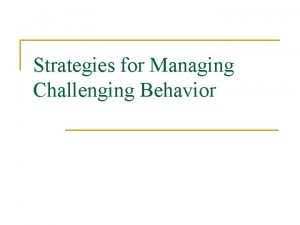Individualized Intensive Interventions Determining the Meaning of Challenging


















































- Slides: 50

Individualized Intensive Interventions: Determining the Meaning of Challenging Behavior Module 3 a

Topics • Case study illustrations • Understand form and function of challenging behavior • Learn the process to develop and implement a behavior support plan

Intensive Individualized Interventions • Examine the Inventory of Practices • Review the practices listed in the Individualized Intensive level • Select your 3 greatest strengths and put a * by them • Identify the three practices you could improve, mark with a √ • Share 1 strength and 1 area to improve p. 13 - 14

Challenging Behavior What we are referring to when we say “challenging behavior” is: • Any repeated pattern of behavior that interferes with learning or engagement in pro-social interactions with peers and adults. • Behaviors that are not responsive to the use of developmentally appropriate guidance procedures. • Prolonged tantrums, physical and verbal aggression, disruptive vocal and motor behavior (e. g. , screaming, stereotypy), property destruction, self-injury, noncompliance, and withdrawal.

Individualized Interventions Supporting Children with Persistent Challenging Behavior

Intensive Individualized Interventions Intensive individualized interventions are used with children who have very persistent and severe challenging behavior and do not respond to the typical preventive practices, child guidance procedures, or social emotional teaching strategies that would normally work with most children.

Group Discussion: Challenging Behavior Challenges Using chart paper: • List challenging behaviors • List interventions that you have tried for those behaviors • Were the interventions effective?

Individualized Positive Behavior Support (I-PBS) • An approach for changing a child’s behavior • Is based on humanistic values and research. • An approach for developing an understanding of why the child has challenging behavior and teaching the child new skills to replace challenging behavior. • A holistic approach that considers all of the factors that impact on a child, family, and the child’s behavior.

Research on I-PBS • Effective for all ages of individuals with disabilities 2 -50 years. • Effective for diverse groups of individuals with challenges: mental retardation, oppositional defiant disorder, autism, emotional behavioral disorders, children at risk, etc. • PBS is the only comprehensive and evidencebased approach to address challenging behavior within a variety of natural settings.

Old Way – New Way Old Way New Way • General intervention for all behavior challenges • Intervention matched to purpose of the behavior • Intervention is reactive • Intervention is proactive • Focus on behavior reduction • Quick fix • Focus on teaching new skills • Long-term interventions

Challenging Behavior Communicates • Communicates a message when a child does not have language. • Used instead of language by a child who has limited social skills or has learned that challenging behavior will result in meeting his or her needs.

Challenging Behavior Works • Children engage in challenging behavior because “it works” for them. • Challenging behavior results in the child gaining access to something or someone (i. e. , obtain/request) or avoiding something or someone (i. e. , escape/protest).

Brendan with a Support Plan SUPPORTS Social Story Cue Cards Mini-Schedule 13

Dimensions of Communication Every communicative behavior can be described by the form and function. • Form: the behavior used to communicate. • Function: the reason or purpose of the communicative behavior.

Children Communicate in Many Ways: Forms of communication • Words • Sentences • Point to a picture • Eye gaze • Pulling adult • Crying • Biting • Tantrums • ?

Children Communicate a Variety of Messages Functions of communication • Request object, activity, person • Escape demands • Escape activity • Escape a person • Request help • Request social interaction • Comment • Request information • Request sensory stimulation • Escape sensory stimulation • ?

Behavior Equation Trigger Behavior Joey is asked to come to circle. Teacher provides physical prompt to move him to group. Joey resists, cries, and hits teacher. Maintaining Consequence Teacher moves away from Joey and allows Joey to select a different activity.

Evan is playing with Duplos. He tries to attach a block to his stack of 3. He can’t quite get the blocks to connect. He looks up at the adult and begins fussing. He holds the stack of blocks up, looks at the blocks, and looks at the adult. The adult helps him put the blocks together.

Evan Trigger Behavior Playing with Duplos, can’t connect blocks. Looks up at adult, fusses, holds up blocks, looks at block/adult. Function: Get help Maintaining Consequence Adult helps put blocks together.

Gabriella is playing in her room. Her mom says, “Come on Gabriella. Time to go to school. ” Her mom pulls on her arm to try to get Gabriella to stand go to the car. Gabriella yells, screams, and begins kicking at her toys. Her mother says, “All right, 5 more minutes. But then we must go. ” Gabriella’s mom walks away, and Gabriella continues playing with her toys.

Gabriella Maintaining Trigger Behavior Consequence Playing in room, Yells, screams, Mom gives her time to get in kicks at toys. five more car for school. minutes of play time. Mom pulls on Function: arm to get to stand. Escapes. Going to the car

Tim is riding a trike on the playground bike path. He sees a child move to the sandbox where Tim had just finished building a roadway. He leaps off his trike and tackles the child. He hits the child. An adult comes over to intervene. She comforts the child and scolds Tim goes to the sandbox and continues construction on his road-way.

Tim Trigger Behavior A child moves to the sandbox where Tim has just built something. Tackles and hits child. Maintaining Consequence Adult intervenes and scolds Tim, comforts other child. Function: Obtain access to roadway Tim continues building roadway.

Madison is in housekeeping, putting on high heels and a hat. Emily moves into the area and selects a purse from the dress-ups box. Madison shouts “no” and bites Emily. A teacher comes over; she asks Madison to go to the thinking chair and takes Emily to the bathroom to look at the bite. After 4 minutes, Madison leaves the thinking chair and returns to housekeeping. She grabs the purse Emily had selected and continues to play. Emily leaves the bathroom with the teacher and then begins an art activity where the teacher is present.

Madison Trigger Behavior Another child moves to area and gets a toy (purse). Shouts “no, ” bites child. Function: Get the purse Maintaining Consequence Sent to “thinking chair, ” other child consoled, four minutes later, Madison leaves chair and returns to play with purse.

Process for Individualized Interventions Step 1: Establishing a collaborative team and identifying goals Step 2: Gathering information (functional assessment) Step 3: Developing hypotheses (best guess) Step 4: Designing behavior support plans Step 5: Implementing, monitoring, evaluating outcomes, and refining plan in natural environments

Potential Team Members • Parents/Family • Teacher(s) • Assisting Teacher/Paraprofessional • Therapists • Administrative Staff • Other(s)

Group Discussion: Welcoming Families Using chart paper: • Identify strategies you have used with family’s to ensure an equal partnership when focusing on their child’s needs. • Identify do’s and don’ts when communicating with families about their child’s challenging behavior. 3 a. 2

Process for Individualized Interventions Step 1: Establishing a collaborative team and identifying goals Step 2: Gathering information (functional assessment) Step 3: Developing hypotheses (best guess) Step 4: Designing behavior support plans Step 5: Implementing, monitoring, evaluating outcomes, and refining plan in natural environments

Functional Assessment • A process for developing an understanding of a child’s challenging behavior and how the behavior is governed by environmental events. • A portfolio of information that provides you with data (e. g. , observations, information) to understand the child • Results in the identification of the “purpose” or “function” of the challenging behavior.

Process of the Functional Assessment • Observe the child in target routines and settings. • Collect data on child behavior, looking for situations that predict challenging behavior and that are linked with appropriate behavior. • Interview persons most familiar with the child. • Review records.

Observation Card Name: General Context: Observer: Date: Time: Social Context: Challenging Behavior: Social Reaction: POSSIBLE FUNCTION: 3 a. 3

Observation Card Example Name: Karen Observer: teacher General Context: Choice time/art Date: 1/22 Time: 10: 00 Social Context: Playing alone in house. Teacher comes over to Karen and asks her to come to the art table for art. When she doesn’t respond, the teacher tries to assist her by taking her arm to nudge her to stand. Challenging Behavior: Karen pulls away and begins to protest by saying, “No! I not go to art!” as she pulls away from the teacher. Social Reaction: The teacher walks away and says, “I will be back in a few minutes to see if you are ready. ” POSSIBLE FUNCTION: Escape art

Scatter Plot Student: Observer: Dates: Rachel Maya 10/1 through 10/12 Target Behavior: Hitting Peers Using a scatter plot involves recording the times of day (and/or activities) in which the behavior does and does not occur to identify patterns over days or weeks Dates Time 7: 30 Activity 10/1 10/2 10/3 10/4 10/5 10/8 10/9 10/10 Arrival Free Choice 9: 00 Planning 9: 30 Centers 10: 30 Snack 11: 00 Outside 11: 30 Small Group 12: 00 Lunch 12: 30 Nap 1: 30 Outside 2: 30 P. M. Circle 3: 00 Departure Behavior did not occur Behavior did occur NA Did not observe 10/11 10/12

Everybody Helps • Family collects data • Educational staff collects data • Therapists collect data • Collect data in ALL settings

“KIS” “KIS it” (Keep It Simple) - - Create simple, user-friendly forms to collect information (e. g. , rating scales, checklists).

Home Observation Card 3 a. 4

Home Observation Card 3 a. 4

Functional Assessment Interview • Define behavior (describe what you see) • Describe frequency and intensity • Explore related factors (e. g. , sleep, medications) • Identify predictors (triggers) • Identify maintaining consequences • Identify current communicative functions • Describe efficiency of the behavior • Describe previous efforts • Identify possible reinforcers 3 a. 5

Large Group Activity: Complete Last Section of Tim’s FAI Immediate Antecedent (Trigger) Problem Behavior Maintaining Consequences LINK TO ANSWER Function

Process for Individualized Interventions Step 1: Establishing a collaborative team and identifying goals Step 2: Gathering information (functional assessment) Step 3: Developing hypotheses (best guess) Step 4: Designing behavior support plans Step 5: Implementing, monitoring, evaluating outcomes, and refining plan in natural environments

Hypotheses Statements • Triggers of the challenging behavior • Description of the challenging behavior • Responses that maintain the challenging behavior • Purpose of the behavior 3 a. 7

Tim’s Support Planning Chart Hypothesis Trigger Behavior • Group play: centers and Verbal aggression outside play (threats), physical aggression (hit, push, kick, punch), property destruction Function: obtain toy/play Preventions New Skills Maintaining Consequence • Peers give up toys/items • Peers leave area • Adults intervene with negative attention on Tim New Responses

Hypothesis Statement In group play situations (outside play/centers), Tim uses verbal aggression (threats), physical aggression (hit, push, kick, punch), and property destruction (throwing or banging toys) to obtain toys and/or join play. When this occurs, the peer relinquishes the desired toy and leaves the play area and/or an adult intervenes and provides Tim with excessive negative attention.

Hypothesis Statement Billy will use tantrums to request a social interaction. Billy will initiate a chase game or request to be held by pulling the adult’s hand or positioning the adult. If the adult does not comply, Billy will cry loudly, scream, and bring his hands to his face or ears. Often the adult will comply with his request or pick him up.

Not Sure About the Hypothesis? • What would make the challenging behavior stop? Is it something you would provide or allow the child to access? Or is there something to remove? Or can you allow the child to leave? • If still unsure, collect more data in the same context. • Some challenging behavior may have the same form but serve multiple functions. • Some challenging behaviors may begin around one function (e. g. , escape) and continue to serve another function (e. g. , gain attention).

Working as a Collaborative Team • Assign roles. • Determine agenda and time for meetings. • Ensure group participation through facilitation and participatory processes.

Roles • Facilitator – person who • Reporter – person who guides group in stating shares group information, agenda, work goals, time makes presentation allocation • Encourager – person who • Recorder – person who provides feedback to group writes down the members discussion • Jargon-buster – person who asks the question • Time Keeper – Person “what do you mean when who tracks time and you say ‘gobbley-gook’ and warns when agenda item helps the group with is ending communicating clearly

Hypothesis Development • Assign roles. • Review child description, observation, and interview. • Complete final page of interview. • Determine functions of challenging behavior. • Write hypothesis statement for at least one function. • Report to group. 3 a. 8 D, 3 a. 8 P, 3 a. 8 SH

Major Messages 1. Challenging behavior has meaning for the child. 2. Children use behavior to access something or someone (obtain/request) or avoid something or someone (escape/protest). 3. The process of Functional Assessment is used to determine the function or purpose of challenging behavior. 4. Hypotheses statements describe the triggers, challenging behavior, maintaining consequences, and function. 3 a. 9
 Individualized consideration
Individualized consideration Individualized consideration
Individualized consideration Idealized influence charisma
Idealized influence charisma Differentiated instruction vs individualized instruction
Differentiated instruction vs individualized instruction Edugains iep
Edugains iep Individualized rating scale
Individualized rating scale Individualized family service plan example
Individualized family service plan example Center for individualized medicine
Center for individualized medicine Individualized healthcare
Individualized healthcare What i found challenging
What i found challenging Cpt abc worksheet example
Cpt abc worksheet example Challenging resistance to change
Challenging resistance to change Challenging behaviour scenarios
Challenging behaviour scenarios Challenging text examples
Challenging text examples Exciting, boring, dangerous, safe, interesting, challenging
Exciting, boring, dangerous, safe, interesting, challenging Time intensity model challenging behaviour
Time intensity model challenging behaviour Children challenging industry
Children challenging industry Periodic table sentences
Periodic table sentences System development life cycle implementation phase
System development life cycle implementation phase Dealing with challenging patients
Dealing with challenging patients Feasibility study phase of sdlc
Feasibility study phase of sdlc Pronouns examples
Pronouns examples Meaning of intensive pronoun
Meaning of intensive pronoun How can ngt be used for requirements determination?
How can ngt be used for requirements determination? Earthquake p-wave and s-wave travel time graph
Earthquake p-wave and s-wave travel time graph Polymer molecular weight determination methods
Polymer molecular weight determination methods How to determine the rate determining step
How to determine the rate determining step What is the point estimate of μ?
What is the point estimate of μ? Margin of safety sales formula
Margin of safety sales formula Oxidation number
Oxidation number Algor mortis worksheet
Algor mortis worksheet Level of product availability
Level of product availability Determining human information requirements
Determining human information requirements Do not use key signature
Do not use key signature Hittorf rule of migration of ions
Hittorf rule of migration of ions Chardakov method lab report
Chardakov method lab report Application problem 3-1 accounting answers
Application problem 3-1 accounting answers How to determine infinite limits
How to determine infinite limits Determining human information requirements
Determining human information requirements Teacher twins@2014
Teacher twins@2014 Copper chloride electron configuration
Copper chloride electron configuration Determine
Determine Determining equilibrium constant using spectrophotometry
Determining equilibrium constant using spectrophotometry Identify zero force members in the truss
Identify zero force members in the truss Determining system requirements
Determining system requirements Determining comparative advantage output method
Determining comparative advantage output method Entrepreneur feasibility analysis
Entrepreneur feasibility analysis Determining optimal capital structure
Determining optimal capital structure Hard customer defined standards
Hard customer defined standards Determining ionization energy
Determining ionization energy A good layout requires determining
A good layout requires determining

